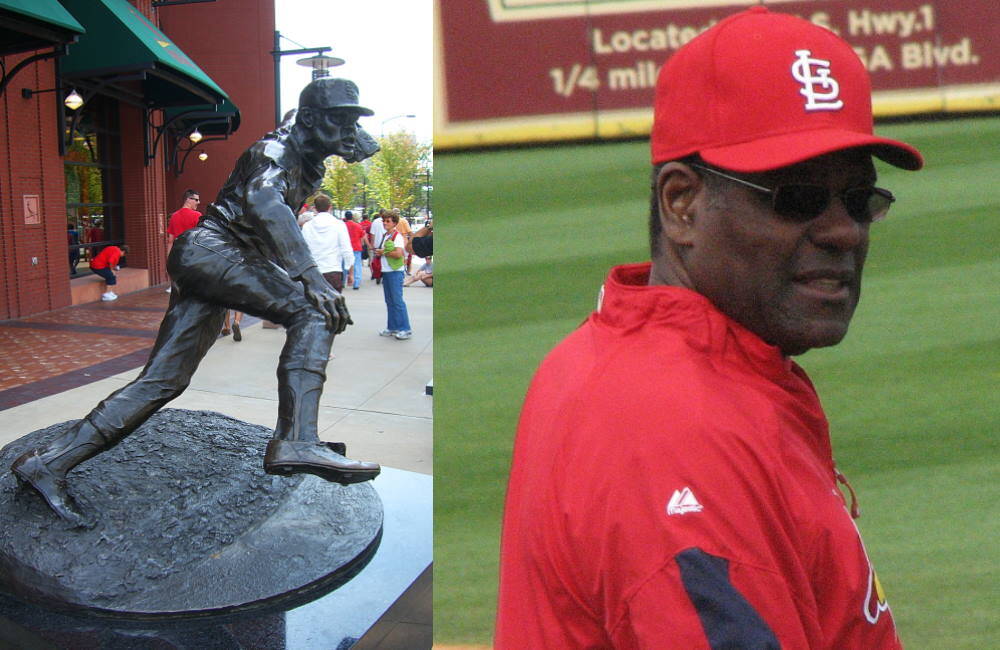One of the greatest pitchers to ever take the mound, Bob Gibson spent his entire career with the St. Louis Cardinals. He not only dominated during the regular season, but also pitched his best in the most high-stress, crucial games.
That ability to do well in big games included a 7-2 record and 1.92 ERA in World Series games.
He also racked up an amazing number of awards, championships and milestones. They included:
- 251 career wins
- 3,117 career strikeouts, the first player to do so since Walter Johnson in the 1920s
- A career 2.91 ERA
- Named to nine All-Star teams
- Winner of Nine Gold Gloves
- Won three National League pennants
- Won two World Series championships
- Won two Cy Young Awards
- Named the 1968 National League Most Valuable Player
Not surprisingly, Gibson was elected to the Baseball Hall of Fame in 1981 in his first year of eligibility.
Bob Gibson’s Early Life
Pack Robert Gibson was born Nov. 9, 1935 in Omaha, Nebraska, the youngest of seven children. His mother worked in a laundry and cleaned houses to make ends meet. Gibson’s father died shortly before his birth. His oldest brother, Josh, ended up taking on the role of mentor and surrogate father.
In the book “Stranger To The Game: The Autobiography of Bob Gibson,” Gibson wrote that Josh “had always been the central figure in my life – father, coach, teacher, and role model. Josh led by example. He required no more from any of us than he gave himself.”
Gibson played track, basketball and baseball at Omaha Technical High School. Josh insisted that he earn a college degree, much as Josh had done himself. Gibson attended Creighton University on a basketball scholarship, although he also played baseball.
After graduation in 1957, his basketball skills were so good that he earned an offer to play with the Harlem Globetrotters. However, he also received an offer from the St. Louis Cardinals. He ended up signing a deal that allowed him to play four months traveling with the Globetrotters, after which he joined the Cardinals. After spending 1957 and 1958 in the minors in Nebraska, Georgia and New York, Gibson made the Cardinals rosters in 1959.
Best Baseball Moments in the 1950s
Bob Gibson’s Major League Career
Things did not start great for Gibson. He earned his first win on July 30, 1959, but the Cardinals manager moved him between the bullpen and the rotation. Gibson also later said that the manager, Solly Hemus, had convinced him he was not good enough to pitch in the majors. He said that he began to believe it.
In both 1959 and 1960, Gibson shifted back and forth between the minors and the majors. The big change came in July 1961, when Hemus was fired and new manager Johnny Keane – who had worked with Gibson in the minors – put him into the starting rotation. Gibson won 11 games and finished the season with a 3.24 ERA.
He had proved to himself he belonged in the majors, after all. He never looked back.
The domination began in 1962. Gibson struck out 208, the first of nine seasons in which Gibson struck out more than 200. He also won 15 and finished the season with a 2.85 ERA. He made the All-Star team for the first of nine times and at one point in the season pitched 22 ⅔ consecutive scoreless innings.
But 1964 made him a legend. On the national stage, in the World Series against the New York Yankees, Gibson won two games, struck out 31, and got the final out in a complete game effort in Game 7 to give the Cardinals the championship (their first since 1946).
Yankees World Series Wins 1903 - Present
In 1968, he outdid himself. It is still considered one of the greatest seasons by any pitcher in the history of baseball. He finished the season with a 22-9 record, 268 strikeouts, 13 shutouts and an amazing 1.12 ERA, the lowest in baseball since 1914. Gibson is one of the main reasons that 1968 is still called “The Year of the Pitcher” (the Detroit Tigers’ Denny McClain is another).
Best Moments of Detroit Tigers Baseball
Gibson won both the National League Cy Young and the National League MVP award in 1968. He also struck out 17 batters in Game 1 of the World Series, a record. Baseball ended up lowering the pitching mound in 1969 from 15 inches to 10 inches, partly in reaction to Gibson’s dominance.
It didn’t stop Gibson. While he didn’t win another championship, he won another Cy Young in 1970. Gibson continued to dominate pitchers with a fastball and devastating slider. He also tended to pitch inside to overly aggressively batters, and had a fierce look on the mound.
Best Baseball Moments in the 1970s
The Baseball Hall of Fame wrote of Gibson: “Bob Gibson may well have been the most intimidating pitcher in history. He was certainly one of the most successful.”
Gibson retired, at the age of 39, in 1975. After baseball, Gibson served as a pitching coach for the New York Mets and Atlanta Braves. He also became a special instructor for the Cardinals in 1996. In addition to induction in the hall of fame, Gibson’s No. 45 was also retired by the Cardinals.
Gibson died on Oct. 2, 2020, after battling pancreatic cancer.


Bob Gibson was among the greatest pitchers I ever saw. Living in New York City I had the honor of seeing hima number of times when he pithced against trhe New York Giants, Brooklyn Dodgers and New York Mets. Also, in the world series against the New York Yankees. The NY Giants had a pitcher, Sal Maglie, wosee nickname was “The Barber” because he pitched close to a hitter. Bob Gibson also pitched so close to hitters that he frequently would have words with them. His stare would quiet them up.